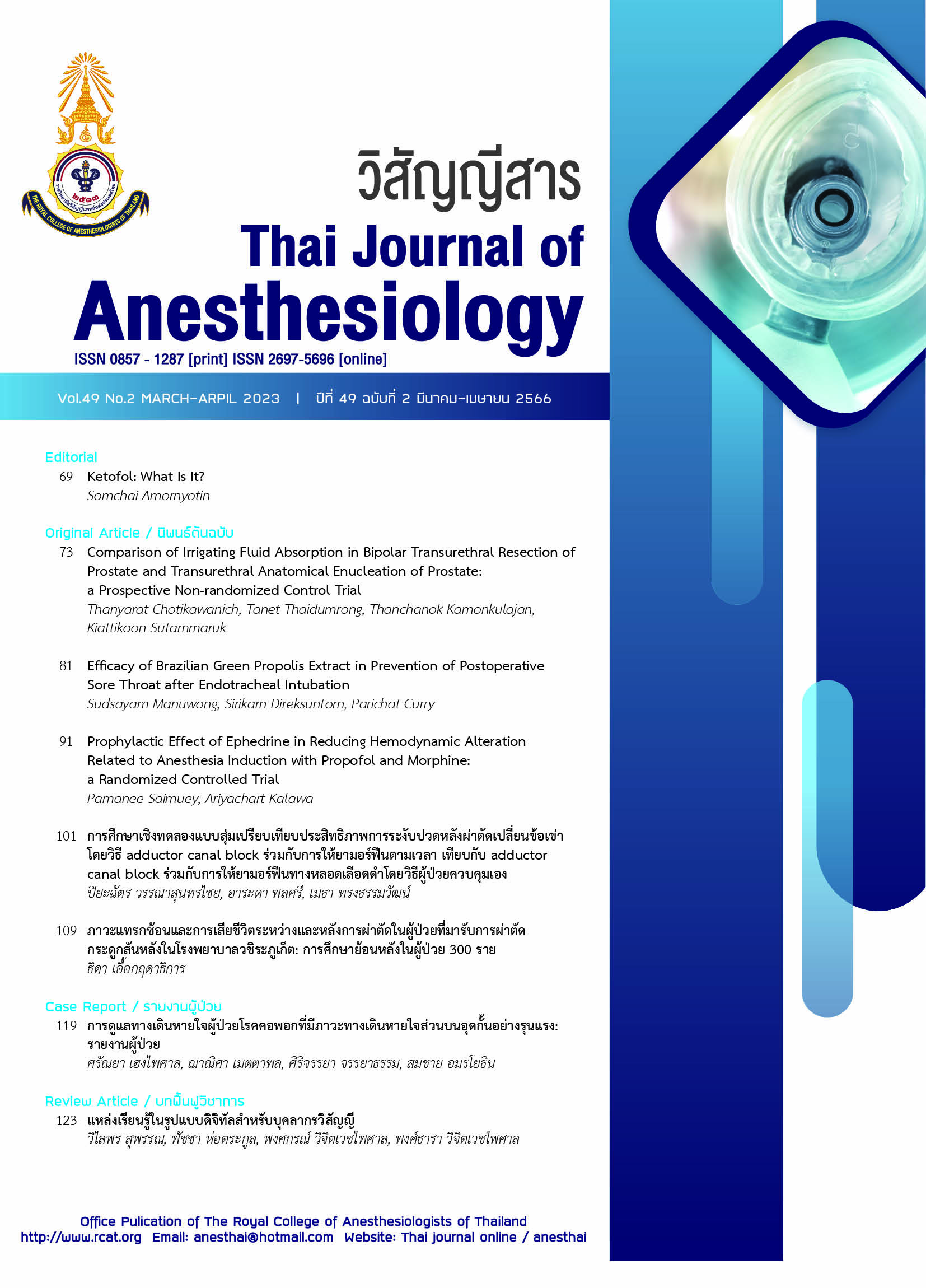Comparison of Irrigating Fluid Absorption in Bipolar Transurethral Resection of Prostate and Transurethral Anatomical Enucleation of Prostate: a Prospective Non-randomized Control Trial
Main Article Content
Abstract
Introduction: Transurethral resection prostate (TURP) is a standard procedure for benign prostate gland hyperplasia (BPH), and the worst complication is the TURP syndrome. New surgical techniques and instrumentations, bipolar transurethral anatomic enucleation prostate (TUAEP) has been proposed aimed to reduce blood loss and fluid re-absorption. However, the fluid absorption and related systemic outcomes of this procedure has not been reported. Objective: This study aimed to compare the fluid absorption between TURP and TUAEP. Methods: Thirty-eight patients, aged 50-85 years old, and ASA status I or II were included for both groups. The procedure was done under spinal anesthesia. Both procedures were conducted using normal saline irrigation. Multi-parameters were collected including fluid absorption, hemoglobin, and blood chemistry at perioperative period. The ethanol was mixed into the irrigating fluid to be 1% of concentration. The fluid absorption was determined by using the alcolmeter. The parameters and the clinical status were compared between two groups. Results: There were 38 patients in the study. Pre-operative prostate weight in the TUAEP group was 53.6±24.4 gm and for TURP group was 29.8±20.0 gm. The resected prostate tissue in TUAEP and TURP was 30-115 gm (median=46 gm) and 5-47 gm (median=17 gm), respectively. The median fluid absorption for TURP was 1,300 ml and 1,622 ml for the TUAEP (P=0.13). Neither type of surgery nor prostate weight related to fluid absorption. Conclusion: The irrigating fluid absorption did not relate to the surgical technique. Increasing fluid absorption was correlated with the operative time.
Article Details

This work is licensed under a Creative Commons Attribution-NonCommercial-NoDerivatives 4.0 International License.
References
Hahn RG. Fluid absorption in endoscopic surgery. Br J Anaesth. 2006;96:8-20.
Bhansali M, Patankar S, Dobhada S, Khaladkar S. Management of large (>60 g) prostate gland: PlasmaKinetic Superpulse (bipolar) versus conventional (monopolar) transurethral resection of the prostate. J Endourol. 2009;23:141-5.
Mebust WK, Holtgrewe HL, Cockett AT, Peters PC. Transurethral prostatectomy: immediate and postoperative complications. a cooperative study of 13 participating institutions evaluating 3,885 patients. J Urol. 1989;141:243-7.
Hahn RG. Early detection of the TUR syndrome by marking the irrigating fluid with 1% ethanol. Acta Anaesthesiol Scand. 1989;33:146-51.
Hahn RG. Ethanol monitoring of irrigating fluid absorption. Eur J Anaesthesiol. 1996;13:102-15.
Hahn RG. Transurethral resection syndrome from extravascular absorption of irrigating fluid. Scand J Urol Nephrol. 1993;27:387-94.
Hahn RG. Fluid and electrolyte dynamics during development of the TURP syndrome. Br J Urol. 1990;66:79-84.
Hahn RG. Fluid absorption and the ethanol monitoring method. Acta Anaesthesiol Scand. 2015;59:1081-93.
Cetinkaya M, Ozturk B, Akdemir O, Ozden C, Aki FT. A comparison of fluid absorption during transurethral resection and transurethral vaporization for benign prostatic hyperplasia. BJU Int. 2000;86:820-3.
Gravenstein D. Transurethral resection of the prostate (TURP) syndrome: a review of the pathophysiology and management. Anesth Analg. 1997;84:438-46.
Madsen PO, Naber KG. The importance of the pressure in the prostatic fossa and absorption of irrigating fluid during transurethral resection of the prostate. J Urol. 1973;109:446-52.
Ran L, He W, Zhu X, Zhuou Q, Gou X. Comparison of fluid absorption between transurethral enucleation and transurethral resection for benign prostate hyperplasia. Urol Int. 2013;91:26-30.

